Chapter 20.139
RESIDENTIAL DESIGN STANDARDS
Sections:
20.139.015 Residential garage configuration standards.
20.139.020 Garage placement and design.
20.139.022 Driveway standards for front-loaded townhomes, attached homes and duplexes.
20.139.030 Architectural details.
20.139.035 Architectural variety.
20.139.040 Building materials.
20.139.050 Accessory building standards.
20.139.055 Side-by-side duplex and attached house standards.
20.139.060 Back-to-back duplex standards.
20.139.065 Residential walls and fences standards.
* Prior legislation: Ords. 022-17 and 010-18.
20.139.005 Purpose.
The purpose of this chapter is to protect the public health, safety and welfare of Port Orchard by guiding development to ensure that:
(1) Residential structures are designed and constructed in an attractive manner;
(2) Property values are protected;
(3) On- and off-street parking areas are used efficiently;
(4) Public spaces are visible from private living areas; and
(5) Neighborhoods are healthy, walkable places. (Ord. 011-19 § 5 (Exh. 2)).
20.139.010 Applicability.
(1) The standards in this chapter shall apply to detached houses, backyard cottages, cottage courts (cottages), side-by-side duplexes, back-to-back duplexes, attached houses, townhouses, and accessory buildings as defined in Chapter 20.32 POMC, in any zone in which they are built as indicated herein. For existing structures that are being modified or enlarged, the standards shall only apply to the portions of the structure being modified and to any additions, unless the project valuation exceeds 50 percent of the taxable value for the structure.
(2) When the project valuation exceeds 50 percent of the taxable value for the structure, the entire structure shall be brought into compliance with this chapter; except that for any portion of the existing building to which an owner is not proposing structural changes, the city shall not require that portion of the existing building to be modified in the following ways (except when required pursuant to the city’s building codes):
(a) Moving an existing exterior wall;
(b) Adding additional windows to an existing exterior wall;
(c) Enlarging an existing covered entry;
(d) Relocating an existing garage or driveway;
(e) Replacing existing siding material; and
(f) Modifying an existing roofline. (Ord. 056-19 § 26; Ord. 011-19 § 5 (Exh. 2)).
20.139.015 Residential garage configuration standards.
(1) The configuration and maximum number of garage bays for the building types listed below shall be limited based on lot width as follows:
|
Building Type |
Lot Width |
Maximum number of side-by-side enclosed standard parking stalls when vehicle access is from primary street |
|---|---|---|
|
Detached House |
<40 feet |
1 |
|
|
40 feet up to 60 feet |
2 |
|
|
≥60 feet up to 100 feet |
3 |
|
|
>100 feet |
No limit |
|
Backyard Cottage |
N/A |
N/A |
|
Side-by-Side Duplex |
74 feet or less |
1 per unit |
|
|
>74 feet |
2 per unit |
|
Duplex Back-to-Back |
40 feet or less |
1 for the front unit, no limit for rear unit |
|
|
>40 feet |
2 for the front unit, no limit for rear unit |
|
Attached House |
40 feet or less |
1 per dwelling unit |
|
|
>40 feet |
2 per unit |
|
Townhouse |
<30 feet |
Not permitted |
|
30 feet or more |
1 per unit |
|
|
Accessory Buildings |
N/A |
N/A |
(2) A side-by-side interior parking space shall mean an area within a structure designed for the storage of a single passenger car or light truck. (Ord. 014-20 § 5; Ord. 056-19 § 27; Ord. 011-19 § 5 (Exh. 2)).
20.139.020 Garage placement and design.
(1) The following provisions apply to detached houses, side-by-side duplexes, and back-to-back duplexes:
(a) Where lots front on a public street, and where vehicular access is from the street, garages or carports shall be set back at least five feet behind the ground floor front wall of the occupied portion of a house or front edge of an unenclosed porch.
Exceptions:
(i) Garages may project up to six feet closer to the street than the ground floor front wall of the occupied portion of a structure or front edge of an unenclosed porch, provided it is set back at least 18 feet from the property line or sidewalk edge (when sidewalks are present) and incorporates at least two of the design/detail features below. Garages placed flush with the ground floor front wall (or between zero and five feet behind the front wall) of the occupied portion of the house shall incorporate at least one of the design/detail features below:
(A) A decorative trellis or arbor over the entire garage face, above and surrounding the garage door.
(B) A balcony that extends out over the garage and includes columns.
(C) Two separate doors for two-car garages instead of one large door.
(D) Decorative windows on the garage door.
(E) Decorative details on the garage door. Standard squares on a garage door will not qualify as a decorative detail. Traditional visible hinges and handles (functional or decorative), and other construction methods creating depth and texture on a garage door surface are acceptable forms of decorative details. Examples of decorative details are shown in Figure 2.
(F) A garage door color (other than white) that matches or complements the color of the house.
(G) Other design techniques that effectively deemphasize the garage, as determined by the director.
(ii) Garages may be placed closer to the street than the front wall of the house or front edge of an unenclosed porch, provided the garage door faces an interior lot line and features (a) window(s) facing the street, so that it appears to be habitable.
(iii) Where lots abut an alley, the garage or off-street parking area shall take access from the alley, unless precluded by steep topography. This requirement shall not apply to unopened alleys.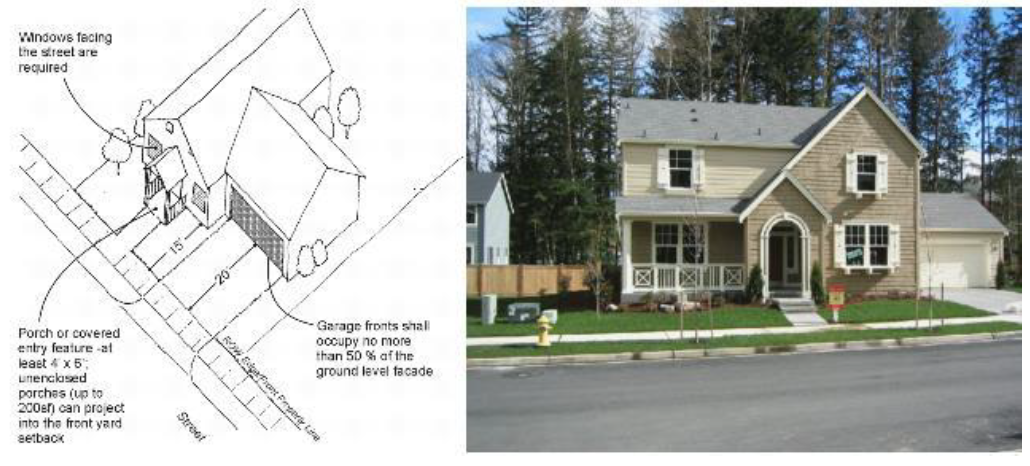
Figure 1. Garage placement/frontage standards and design.
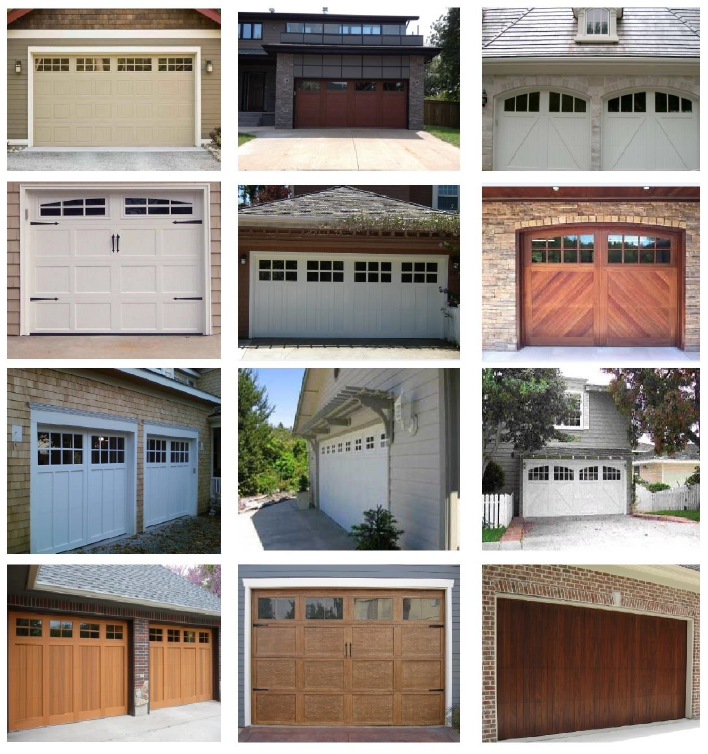
Figure 2. Garage design/detail examples.
(Ord. 059-21 § 14; Ord. 011-19 § 5 (Exh. 2)).
20.139.022 Driveway standards for front-loaded townhomes, attached homes and duplexes.
(1) Individual driveways are limited to a single lane 12 feet wide.
(2) Driveways shared between two townhomes, two attached homes, or two duplex units are limited to 20 feet in width.
(3) In order to qualify for one or more individual or shared driveways, the building in which townhomes, attached homes or duplexes are contained must be at least 30 feet wide. (Ord. 056-19 § 28).
20.139.025 Building design.
This section shall apply to detached houses, cottages within a cottage court, all duplex types, attached houses, and townhouses as defined in Chapter 20.32 POMC.
(1) Porches. All detached houses, cottages within a cottage court, attached houses, and all duplex types shall have a porch meeting the standards of POMC 20.122.060.
(2) Focal Point. All detached houses, cottages within a cottage court, attached houses, all duplex types, and townhouses shall include front doors or windows (excluding windows on a garage door or above a garage door) as a focal point on the front elevation.
(3) Windows and Transparency. All detached houses, cottages within a cottage court, attached houses, all duplex types, and townhouses shall provide windows and meet transparency requirements as follows:
(a) Transparent windows and/or doors facing the street are required. To meet this requirement, at least eight percent of the facade must be transparent. The facade is measured from the base of the house to the start of the roofline and any other vertical walls facing the street, except for gabled portions of the facade not containing livable floor area (see Figure 3 for clarification). Garages located on the street facing wall of the house shall count as part of the facade.
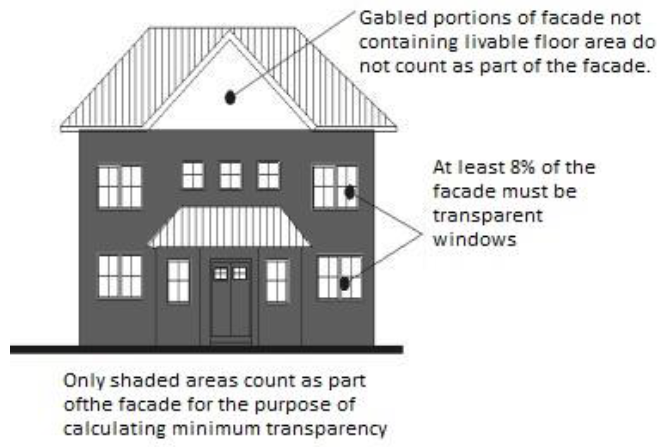
Figure 3. Facade transparency.
(b) Building facades visible from a public street shall employ techniques to recess or project individual windows above the ground floor at least two inches from the facade or incorporate window trim at least three and one-half inches in width that features color that contrasts with the base building color. Exceptions will be considered where buildings employ two or more other distinctive window or facade treatments that add depth and visual interest to the building. Examples of distinctive window or facade treatments are shown in Figure 5. Distinctive window or facade treatments include:
(i) Shutters on all street facing windows.
(ii) A keystone above a window (on masonry homes).
(iii) Windows containing more than two glass panes (or that give the appearance of multiple panes).
(iv) Stained or custom glass.
(v) Exterior window sills.
(vi) Significantly increased facade transparency percentages in a modern architectural application.
(vii) Other design techniques that effectively emphasize windows as an architectural feature as determined by the director.
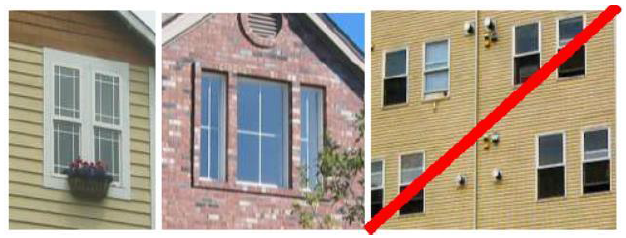
Figure 4. Acceptable (left and middle) and unacceptable (right) window design.
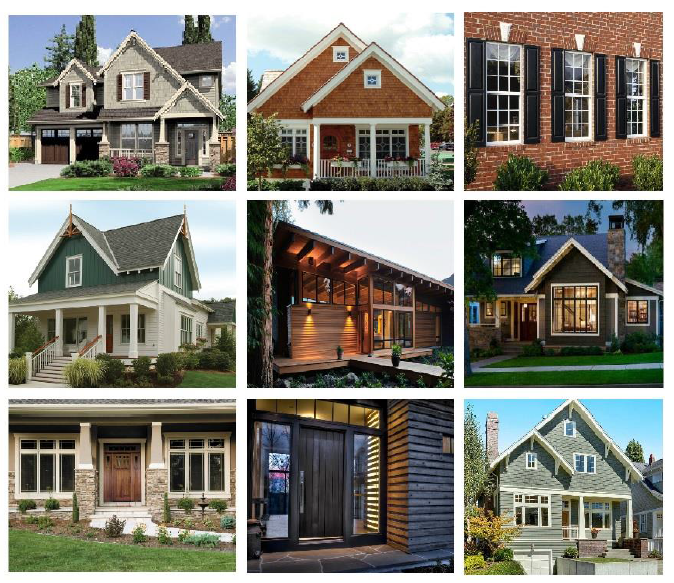
Figure 5. Examples of distinctive window or facade treatments.
(Ord. 011-19 § 5 (Exh. 2)).
20.139.030 Architectural details.
This section shall apply to detached houses, cottages within a cottage court, all duplex types, attached houses, and townhouses.
(1) Architectural Details. Provide for architectural details that add visual interest to the neighborhood and are well proportioned to achieve good human scale. Specifically, incorporate at least three of the following detail elements into the facade of the house:
(a) Decorative porch design, including decorative columns or railings.
(b) Bay windows or balconies.
(c) Decorative molding/framing details around all ground floor windows and doors.
(d) Decorative door design including transom and/or side lights or other distinctive features.
(e) Decorative roofline elements including brackets, multiple dormers, and chimneys.
(f) Decorative building materials, including decorative masonry, shingle, brick, tile, stone, or other materials with decorative or textural qualities.
(g) Landscaped trellises or other decorative elements that incorporate landscaping near the building entry.
(h) Distinctive paint schemes (such as a paint scheme consisting of three or more colors).
(i) Other decorative facade elements or details that meet the intent and standards as determined by the director.
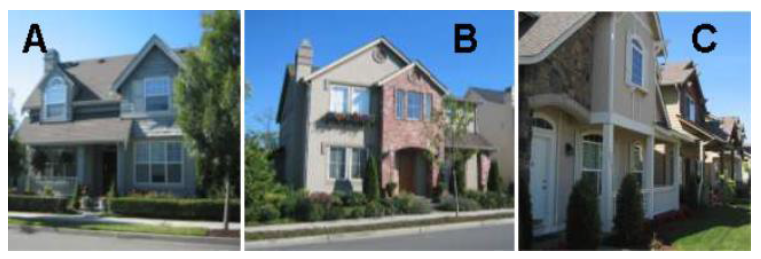
Figure 6. Examples of how houses can meet architectural detail criteria. Image A includes decorative windows, building material treatment, and roofline elements. Image B includes decorative brick use, window treatments, entry design, and ventilation circles. Image C includes decorative building materials, door/entry feature, windows, and roofline elements.
(Ord. 011-19 § 5 (Exh. 2)).
20.139.035 Architectural variety.
This section shall apply to detached houses, all duplex types, and attached houses.
(1) Developments shall achieve architectural variety by accommodating a variety of architectural styles, variations of the same architectural style, and through the use of multiple design elements. Specifically:
(a) Duplicative house designs adjacent to each other are prohibited. Simple reverse configurations of the same house design on adjacent lots are not sufficient to meet architectural variety goals. Exceptions may be granted by the director in special circumstances where similar architectural consistency provides a distinct character for a cluster of homes surrounding an open space or on a particular street (cottage homes in a cottage court for example).
(b) Generally, the more houses in a subdivision or on a street block, the greater the number of different facade elevations will be required. Specifically, the following subdivision and street block variety standards shall apply:
(i) Subdivisions.
(A) Ten to 19 structures, a minimum of four different facade elevations shall be used.
(B) Twenty to 39 structures, a minimum of five different facade elevations shall be used.
(C) Forty to 69 structures, a minimum of six different facade elevations shall be used.
(D) Seventy or more structures, a minimum of seven different facade elevations shall be used.
(ii) Street Block.
(A) Less than six structures, a minimum of three different facade elevations shall be used.
(B) Seven to 10 structures, a minimum of four different facade elevations shall be used.
(C) Eleven to 14 structures, a minimum of five different facade elevations shall be used.
(D) Fifteen or more structures, a minimum of six different facade elevations shall be used.
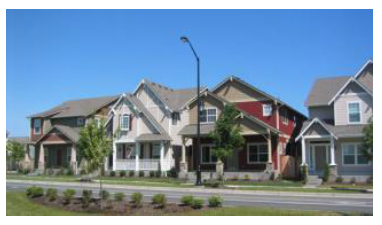
Figure 7. Examples of homes featuring different facade elevations. Notice the different rooflines, entry features, window designs/locations, exterior materials, and colors.
(c) In order to qualify as a different facade elevation, dwellings shall have different roofline configurations, different color palettes, and different porch/entry design. In addition, a minimum of two of the following alternatives shall be utilized:
(i) Different window openings (location and design).
(ii) One- and two-story houses.
(iii) Different exterior materials and finishes.
(iv) Different garage location, configuration, and design.
(v) Other different design element that helps to distinguish one facade elevation from another as determined by the director. (Ord. 011-19 § 5 (Exh. 2)).
20.139.040 Building materials.
This section shall apply to detached houses, cottages within a cottage court, all duplex types, attached houses, and townhouses.
(1) The following building material standards shall be met:
(a) Mirrored glass and exposed concrete block (except for foundation/crawl space walls where not visible from the street) are prohibited. Board form concrete is acceptable.
(b) T-111 siding and other plywood types of siding (board and batten with a brick, stone, or horizontal lap siding lower portion of the building is an exception) shall not be used for facades adjacent to or directly viewable from a street or public place. (Ord. 011-19 § 5 (Exh. 2)).
20.139.045 Roof design.
This section shall apply to detached houses, all duplex types, and attached houses.
(1) A variety of articulated roof forms shall be provided for each individual home that emphasize building form to create visual interest to the neighborhood and to avoid a monotonous series of rooflines. Roof should exhibit variety between different plans by using front-to-rear and side-to-side gabled and hipped roofs, and/or by the introduction of single-story elements. Roof materials, colors and treatments should correspond to the individual character or style of the home and should be compatible with the overall look of the neighborhood.
(2) All buildings with pitched roofs shall have a minimum slope of four feet vertical rise for every 12 feet of horizontal run on the primary roof of the building. A continuous pitched roof shall extend no more than 40 linear feet unless it contains roof elements. Roof elements may include at least one of the following:
(a) Dormers.
(b) Cupolas.
(c) Gable or hip projection.
(d) Hipped roofs or similar construction are encouraged alongside yards in neighborhoods with closely-adjacent homes to maximize solar access to neighboring homes and/or private open space, as shown below.
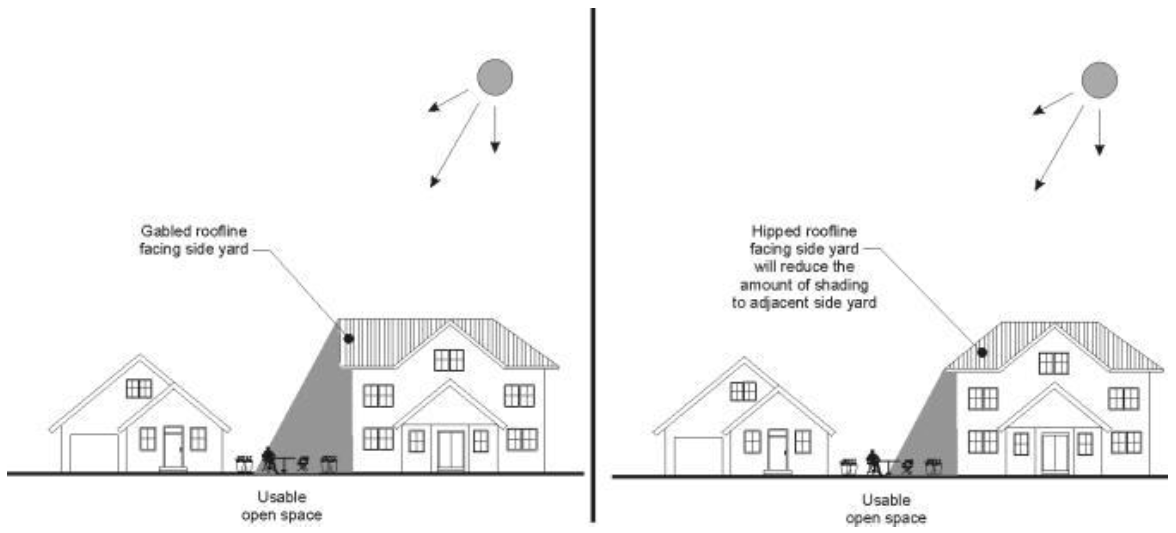
Figure 8. Encourage rooflines along the side yard that maximize solar access to adjacent homes and/or private open space.
(Ord. 011-19 § 5 (Exh. 2)).
20.139.050 Accessory building standards.
Accessory buildings (including detached garages) with more than 200 square feet of floor area shall be designed to be compatible with the primary structure in scale, size, materials, detailing, and roofline, as determined by the director. Accessory buildings of any size that have more than one story (such as a loft, mezzanine or attic space), and accessory buildings that will be located within a required fire separation according to the IRC, may require a building permit. (Ord. 011-19 § 5 (Exh. 2)).
20.139.055 Side-by-side duplex and attached house standards.
Duplexes should be designed similar in nature to single-family homes and shall feature a visible pedestrian entry and windows facing the street. Specifically, duplexes shall comply with all detached single-family design standards in this section with the following exceptions and additional provisions:
(1) For sites without alleys, duplexes may include a 20-foot-wide shared driveway or two 12-foot driveways on opposite ends of the lot.
(2) Separate covered entries for each unit are required with a minimum dimension of four feet by six feet. Porches up to 200 square feet may project into the required front yard by up to six feet.
(3) Duplexes on corner lots shall place pedestrian entries on separate streets.
(4) At least 10 percent of the street-facing facade shall be windows or other glazing (e.g., door glazing).
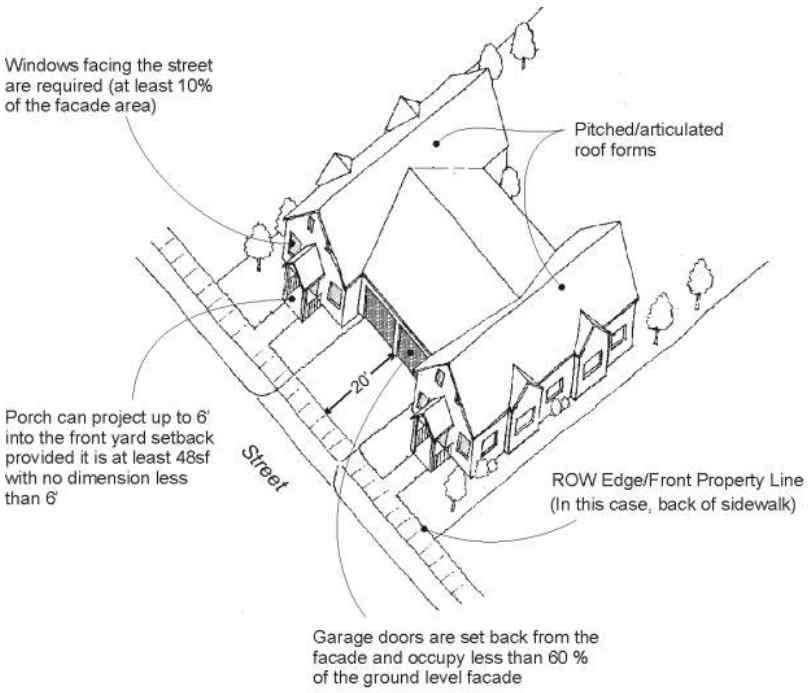
Figure 9. Duplex design standards.
(Ord. 011-19 § 5 (Exh. 2)).
20.139.060 Back-to-back duplex standards.
Back-to-back duplexes shall comply with all of the same standards applicable to detached houses as listed in POMC 20.139.015 through 20.139.045 and for any unit within a back-to-back duplex that abuts a public street. Any rear unit that does not directly abut a public street is encouraged to meet the listed in POMC 20.139.015 through 20.139.045 and to be finished consistent with the forward street abutting unit. (Ord. 011-19 § 5 (Exh. 2)).
20.139.065 Residential walls and fences standards.
(1) General Standards. The following standards shall apply to all residential development:
(a) Fences and walls shall either be finished (i.e., without exposed supports or stringers) on both sides, or else shall be installed so that the finished side faces any street.

(b) Fences and walls shall follow the contour of the ground as far as practicable. Fences on sloped ground may be installed on an incline, or may be installed in stepped sections, with or without an accompanying retaining wall; however, inclined fences and stepped fences and/or walls shall have the fence and/or fence section height measured in the same manner as level fences and shall comply with the maximum height restrictions as provided in this section. Adjustments for grade shall occur at the bottom of the fence to every extent possible. See Figure 11.
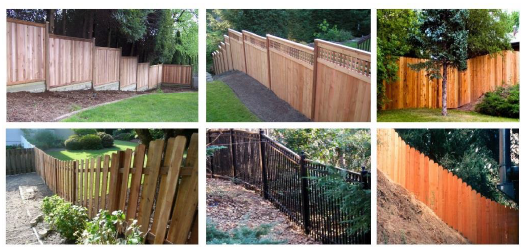
Figure 11: Fences on slopes.
(c) Solid fencing or wall sections more than 200 feet long located along a street shall include architectural features, such as masonry, brick or wood-framed columns to break up the street facing side of the fence. The minimum separation between those features shall be no less than 15 feet.
Examples of acceptable (upper rows) architectural features and unacceptable (bottom row) architectural features are shown in Figure 12.
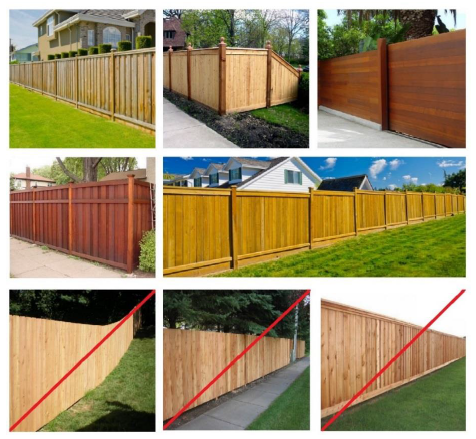
Figure 12. Fences that are broken up with architectural features (top two rows) and those that are not broken up (bottom row).
(d) Approved columns or posts may exceed the height of the fence by one foot and must meet all permit and setback requirements.
(e) Fences shall be maintained in good repair. It shall be a violation of the zoning code to allow a fence to fall into disrepair.
(2) Fence Height. The following standards shall apply to all residential development:
(a) If a minimum linear distance of 10 feet separates a fence and retaining wall, a fence may be erected to a height of six feet above the highest finished grade within the 10-foot distance.
(b) All fences in the primary front yard of single-family, duplex and attached residential uses shall not exceed four feet in height and a minimum 35 percent open area (see Figures 13, 14).
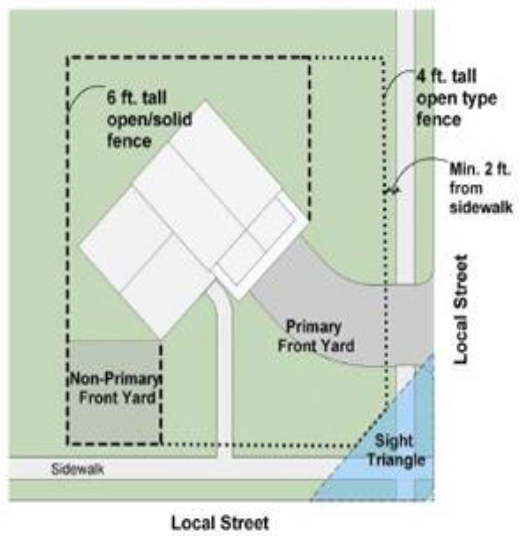 Figure 13. Fence type and height – Front vs. side and rear yard.
Figure 13. Fence type and height – Front vs. side and rear yard.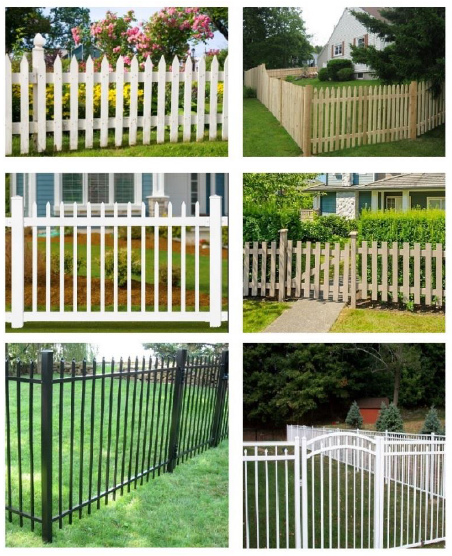
Figure 14: Fences with at least 35 percent open area – open type fence.
(c) All fences in the rear yard, side yard, nonprimary front yard of single-family, duplex, attached residential, and multifamily uses may be solid and shall not exceed six feet in height.
(d) A combination fence and retaining wall may be erected to a height of six feet above the highest finished grade or eight feet above the lowest finished grade, at the location of the fence, except that at no time shall the fence portion exceed six feet above the highest finished grade at any point (see Figure 15).
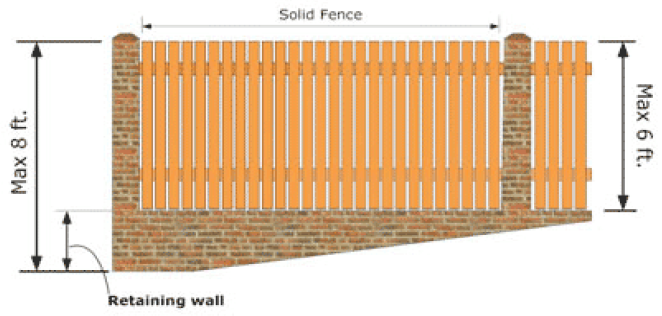
Figure 15: Fence and retaining wall on grade.
(e) A retaining wall may not elevate a fence to any height more than allowed by this section.
(f) An entry feature or trellis may have a maximum height of 10 feet and maximum width of 10 feet.
(3) Fence and Wall Placement. The following standards shall apply to all residential development:
(a) No portion of a fence shall extend beyond the property line of the fenced property into the public right-of-way unless allowed by a right-of-way use permit.
(b) All fences and walls including fence support systems such as posts, pillars and columns shall be set back at least to the property line and a minimum of two feet from the back edge of the sidewalk to allow for safe passage by persons on a sidewalk or traveled walkway or where no sidewalk exists then two feet behind the edge of asphalt.
(c) Vehicular gates must be set back at a minimum 20 feet from the travel surface of the street or back of curb in order to meet vehicle stacking requirements.
(d) Gates adjacent to sidewalks, alleys and public rights-of-way shall open inward to the private property.
(e) A fence along common property lines may be placed at the furthest point forward of the adjacent property if the adjacent property allows for fence placement that differs from the neighbors.
(f) Solid fences and walls may be erected to a height of eight feet to separate a property from an arterial street or a frontage road adjacent to a highway. The director shall consider the aesthetic, visual, and noise reduction characteristics of the fence or wall. A building permit may be required for fences exceeding six feet in height and for walls.
(g) Where a corner lot is permitted to have a solid fence along a nonprimary front property line that coincides with an adjacent property’s primary front yard, no fence will be permitted that creates a site distance hazard for vehicles exiting that property or for pedestrians walking along a sidewalk or traveled walkway.
(4) Residential Fence and Wall Materials.
(a) Approved materials for fence construction include, but are not limited to, commercial quality wood, brick, masonry, metal, stone, wrought iron, manufactured vinyl or PVC fence material or any other material approved by the director, unless otherwise prohibited by this chapter.
(b) Barbed wire or razor wire is not allowed on any property used for residential purposes or any property that has residential zoning.
(c) Electrical fencing is allowed only on properties where legal agricultural uses exist and shall be used solely for the enclosure of livestock. This provision does not prohibit invisible fences.
(d) Combination fences of lattice and other decorative materials may be used in conjunction; however, at no time shall the combination exceed the overall fence height limitation.
(e) Prohibited fence materials shall include, but are not limited to, aluminum siding, vehicle parts, smooth face concrete masonry units/blocks, cloth or plastic tarps, scrap wood or any other material not customarily sold for fencing.
(f) Plastic or temporary construction fence may not be used as a permanent fence material.
(g) Approved materials for wall construction include, but are not limited to: stone, commercial quality brick, decorative masonry units, or decorative concrete or any other material approved by the director unless otherwise prohibited by this chapter. (Ord. 011-19 § 5 (Exh. 2)).


